In 2025, the modern Nigerian bridal style has blossomed into something truly spectacular—an art form that seamlessly blends history with fresh innovation. From the elaborate use of aso oke to fabrics crafted entirely from scratch, today’s brides are telling their love stories not only through tradition but also through couture. They are reimagining the fabrics their mothers once wore, pairing them with daring silhouettes, bold textures, and intricate details that rival any global runway. The result is nothing less than a cultural renaissance, stitched together with beads, lace, and silk.
To fully appreciate this evolution, one must first look at the brides who are setting the pace. In recent years, a handful of weddings have sparked conversations both within Nigeria and across the globe. These ceremonies were not just celebrations of love but also powerful showcases of artistry and cultural pride. From Temi Otedola’s Vogue-featured looks to Priscilla Ojo’s regal ensembles, these brides have emerged as muses for a new generation. Their choices reveal how heritage and global design influences now intertwine, creating unforgettable fashion moments that endure far beyond the wedding day.
Then and Now: A Journey of Evolution
Not too long ago, bridal attire across Nigeria leaned toward restraint. Yoruba brides, for instance, often appeared in aso oke or ankara iro and buba, while other ethnic groups favored wrappers, lace, and similar traditional fabrics. These ensembles carried undeniable cultural weight, yet their silhouettes were predictable, leaving little room for personal reinvention.
Today, however, those same fabrics have been reborn. Lace and aso oke are cut into daring, sculptural shapes; ankara is reimagined through haute couture craftsmanship; and coral beads are no longer mere adornments but serve as both accessories and structural embellishments. Even more striking, Nigerian designers—joined now by international couturiers—are working hand-in-hand with brides to create custom textiles. The results are layered masterpieces, rich with 3D appliqués, metallic embroidery, and handwoven beadwork. This spirit of collaboration has transformed bridal attire into something at once innovative and deeply rooted in culture.
Fabric as a Storytelling Tool
Aso oke, once reserved almost exclusively for Yoruba royalty and traditionally styled as iro and buba, has now emerged as the crown jewel of modern Nigerian bridal fashion. In 2025, designers are reimagining the fabric into sculpted gowns, corseted bodices, and sweeping capes that command attention. More than ever, brides are commissioning bespoke weaves, infused with metallic threads, layered textures, or intricate 3D beadwork, transforming each creation into a singular piece that tells their story.
Temi Otedola: A Vogue Moment for Nigerian Bridal Fashion
Temi Otedola’s #LoveisEazi wedding completely redefined expectations for modern Nigerian bridal attire. Her collaboration with Sohee Park, a London-based designer with Asian roots, marked a true turning point. This was not just a Nigerian wedding; it was a global couture showcase. By weaving Korean embroidery into Yoruba traditions, Temi’s ensembles demonstrated that Nigerian bridal fashion rightfully belongs in the global fashion conversation. Unsurprisingly, Vogue celebrated the milestone, cementing her looks as admired far beyond Africa.
Although she wore four traditional outfits, three in particular stood out as true masterpieces.
Look 1
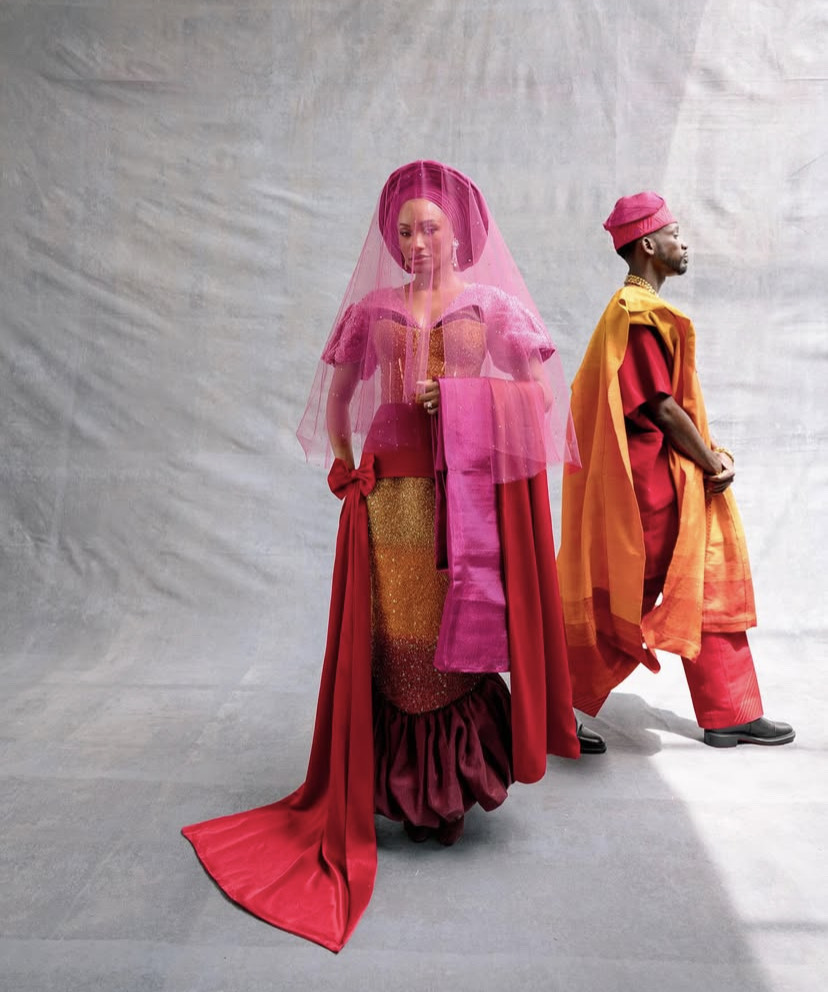
Her first standout look was an ombré creation by Lisa Folawiyo, drawn from years of sketches that finally found their perfect moment. The gown sculpted Temi’s figure with intricate paneling, elevated by Folawiyo’s signature bows, and was hand-embellished for more than 500 hours. The result was a piece that seemed to shimmer with the glow of the evening sun. Its radiant palette, cascading from golden hues into deep reds, paid homage to Yoruba aso oke while pushing it firmly into the realm of couture. With every bead and glimmering detail, heritage fabric was reborn as a luminous masterpiece.
Look 2

Her second standout ensemble, also designed by Lisa Folawiyo, paid a moving tribute to her late mother-in-law’s Igbo heritage. Drawing inspiration from Akwaocha, Folawiyo reimagined the classic white fabric into a striking two-piece set, lavishly adorned with coral embellishments and delicate fringe detailing. Red coral accessories layered Temi in regal splendor, from the necklaces and hairpieces to the beaded sandals, each element tying the look together in a breathtaking fusion of culture and couture.
Look 3
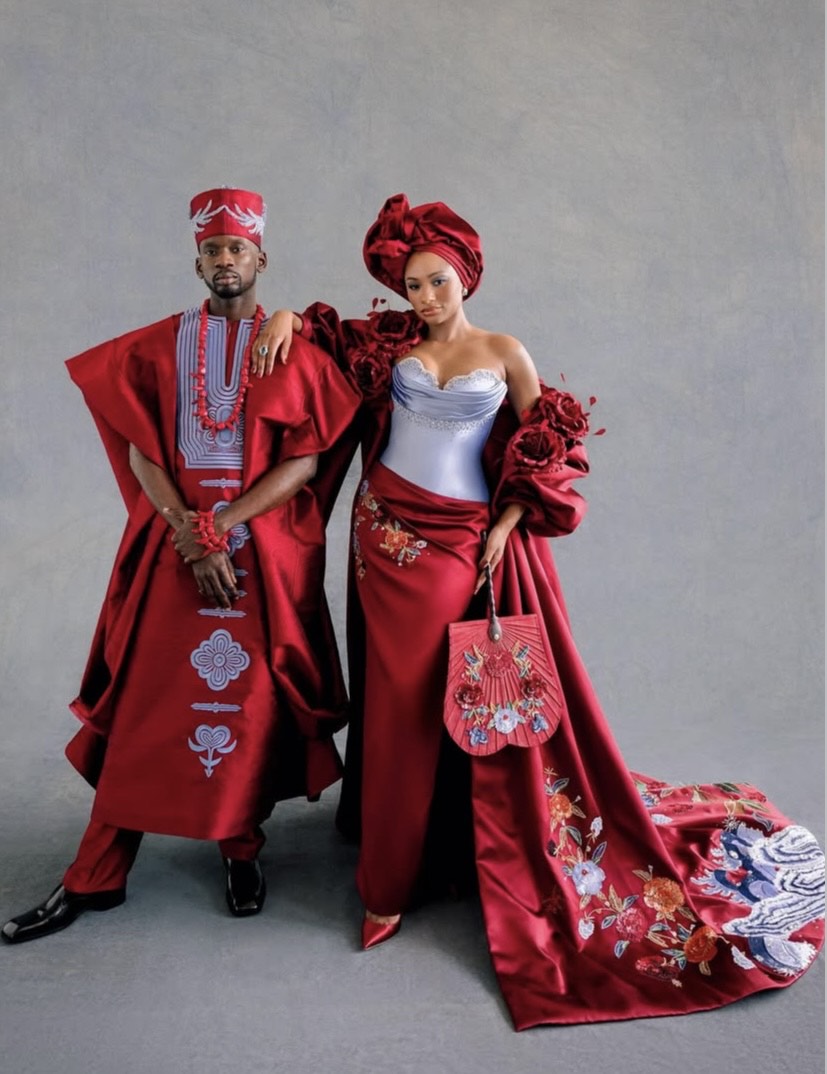
The true highlight, however, came with her collaboration with Sohee Park for one of her reception looks. It was a fusion of Yoruba heritage and Korean artistry that stands as a landmark in modern bridal fashion. At its heart was a dramatic Bordeaux cape, embroidered with handcrafted peonies and butterflies, paired with a Hansan Mos fan, itself a revered Korean heirloom art piece.
The craftsmanship was staggering: seven embroidery artisans, three couturiers, and five handworkers devoted 4,590 hours to the gown and cape, while a master Korean artisan spent 67 hours perfecting the fan. Completed with a deep red duchesse satin skirt, a powder blue strapless bodice, and meticulously embroidered accessories, the look transcended the wedding stage to become a symbol of how Nigerian bridal fashion now commands a place in the global couture conversation.
Toni Tone: Fabric Reinvention and a Grand Display Of Yoruba Spirit

In 2025, Nigerian bridal designers are no longer just tailoring garments; they are inventing entirely new textiles. Brands like Emagine by Bukola are layering crystal beads into wave-like patterns and handcrafting 3D lace from metallic mesh, pushing the boundaries of what bridal couture can be.
This spirit of innovation was on full display at Toni Tone’s wedding, where her attire captured both Yoruba grandeur and the forward momentum of Nigerian fashion. Her first look, a custom aso oke by Amy Aghomi, drew inspiration from the talking drums of Osun State. Rendered in rich purple and pink hues, the gown combined wide, flowing sleeves with intricate beadwork, balancing sound and spectacle in equal measure. The handwoven aso oke, elevated with bead embroidery, transformed tradition into a regal masterpiece that was as cultural as it was couture.
Look 2
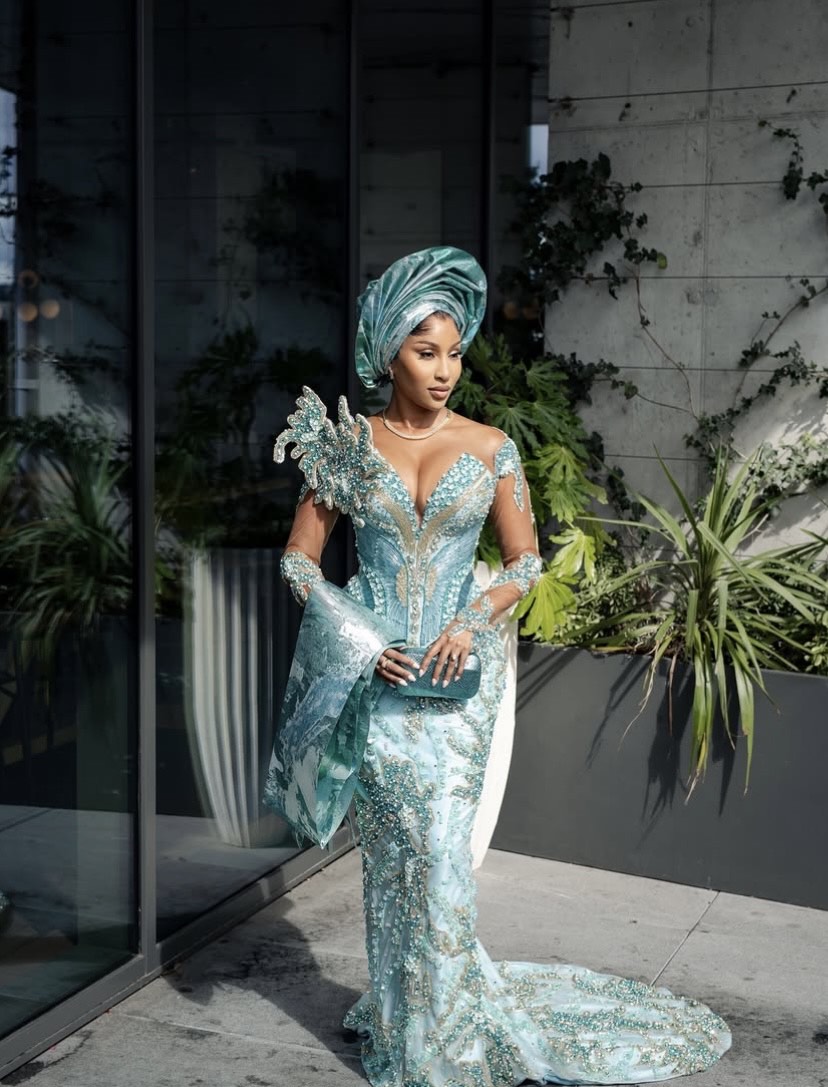
For her second look, Toni collaborated with Emagine by Bukola to bring an entirely new vision to life. The result was a turquoise masterpiece crafted from scratch, where crystal beads were layered into wave-like patterns and metallic mesh was hand-pleated into sculptural 3D lace. Rhinestones scattered across the fabric caught and refracted the light, adding a dazzling dimension to the design. Anchored by a dramatic mermaid silhouette and crowned with an elaborate gele, the ensemble embodied global couture while remaining firmly rooted in Nigerian tradition.
Priscilla Ojo: Cultural Fusion at the Forefront
Priscilla Ojo Mkambala’s #JP2025 wedding proved that modern Nigerian bridal style is no longer bound to a single ethnic lens. Instead, her ensembles wove multiple traditions into a seamless narrative, demonstrating how today’s brides confidently merge heritage and innovation to tell stories that are both personal and expansive.
Look 1
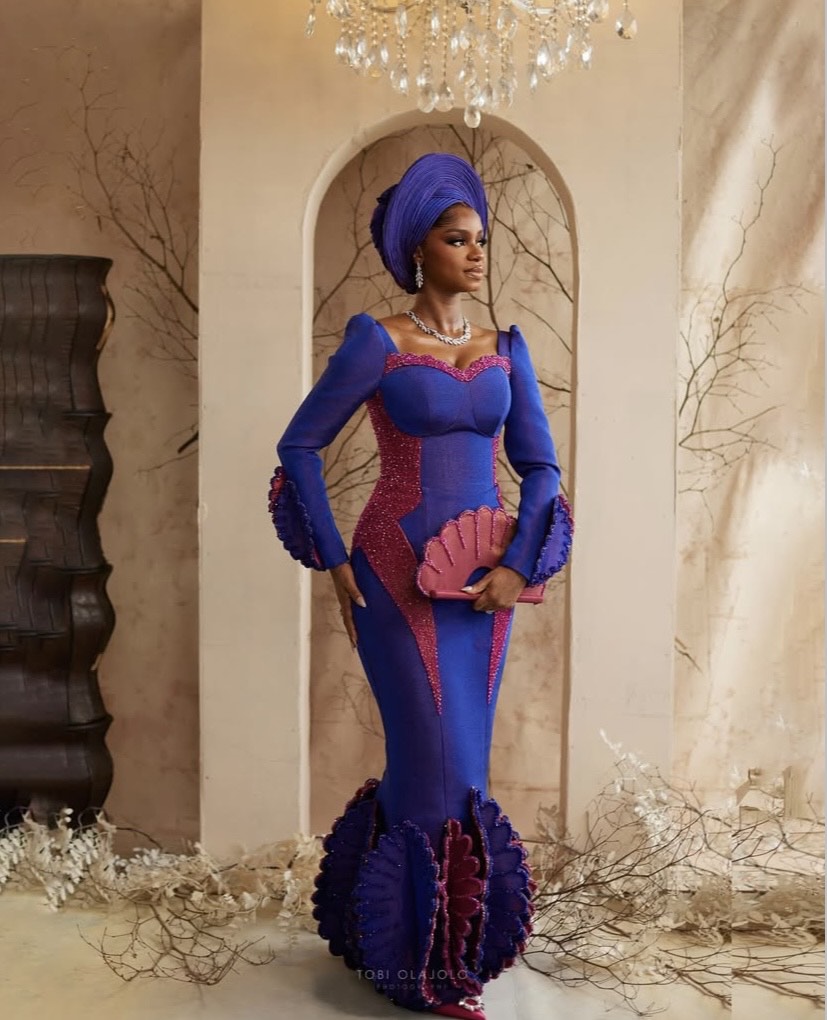
Her first look, designed by Couture by Tabik, was a regal aso oke gown in royal blue and fuchsia pink. Flame-like bead embellishments, scalloped detailing, and a sweetheart neckline gave the attire a balance of tradition and modern sophistication. The rich beading added texture and made the fabric sparkle brilliantly under the light.
Look 2
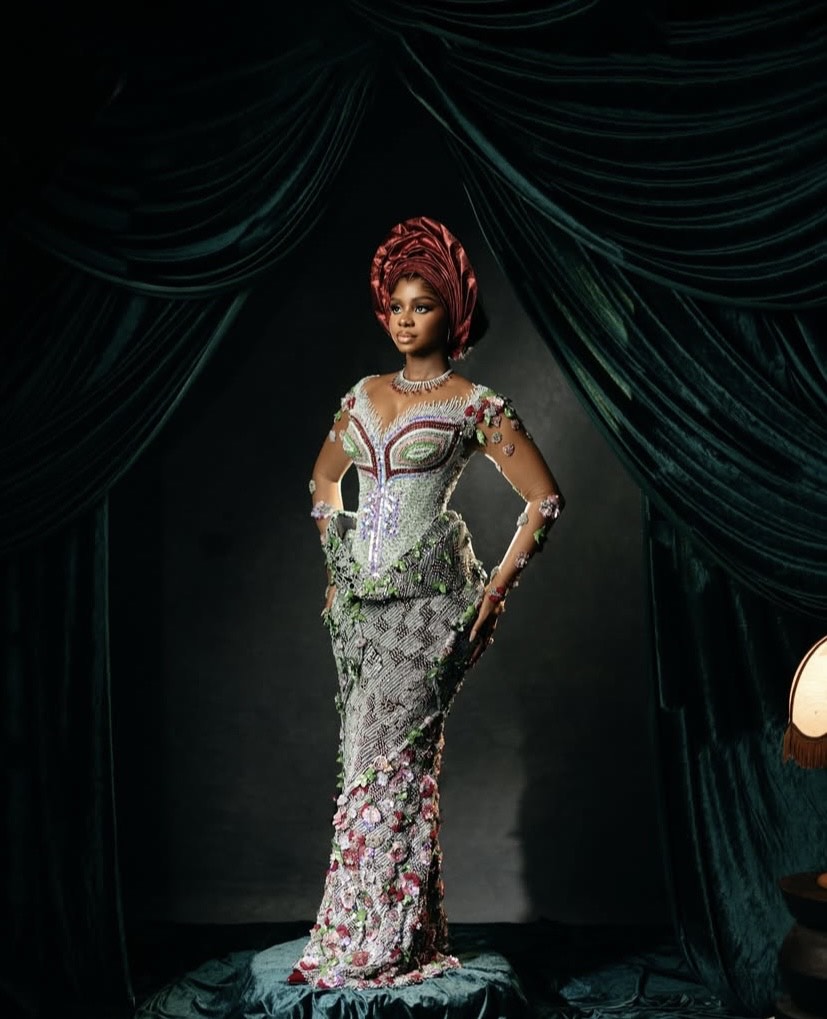
For her second look, Priscilla turned to Emagine by Bukola. This design blended Yoruba and Efik/Igbo influences into a striking fusion. The fitted silhouette, floral appliqués in wine red and green, and intricate beadwork sewn across delicate netting created a dress that embodied both culture and couture. Paired with a burgundy gele, the ensemble showed how one bride could honor multiple heritages while still embracing a global design language.
Veekee James: When the Bride is the Designer
Veekee James’ wedding highlighted how designer-brides can turn their big day into a runway, pushing Nigerian bridal fashion to new heights.
Look 1

Her first gown—a dramatic lace creation in black, green, and purple—featured a corset bodice, cascading embellishments, and sculpted brocade flower sleeves. The ombré gradients in the fabric added depth and luxury, while shimmering details brought the look to life.
Look 2
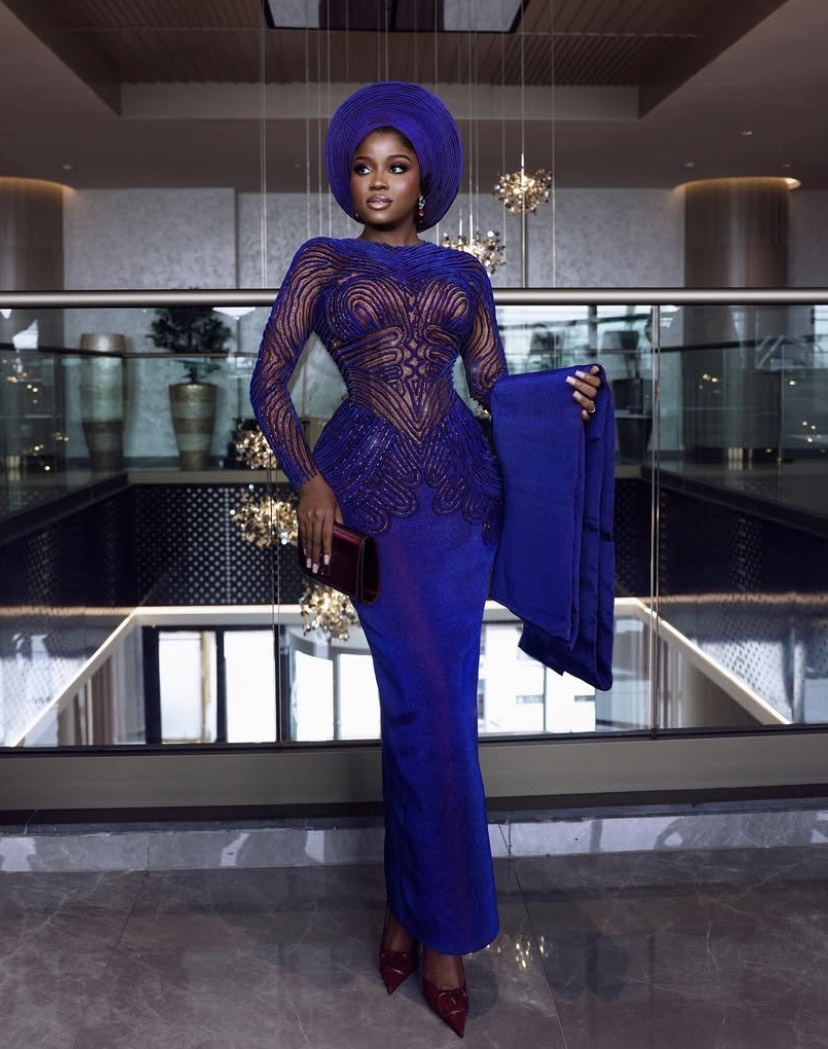
For her second outfit, she chose a royal blue aso oke, reimagined with her brand’s signature flair. The sheer bodice and sleeves carried rich embroidery, while the floor-length skirt flowed with ease. Paired with a gele and a coordinating train draped over one arm, Veekee showed how traditional fabrics can be reborn with modern elegance.
Chioma Adeleke: Accessories as Storytelling
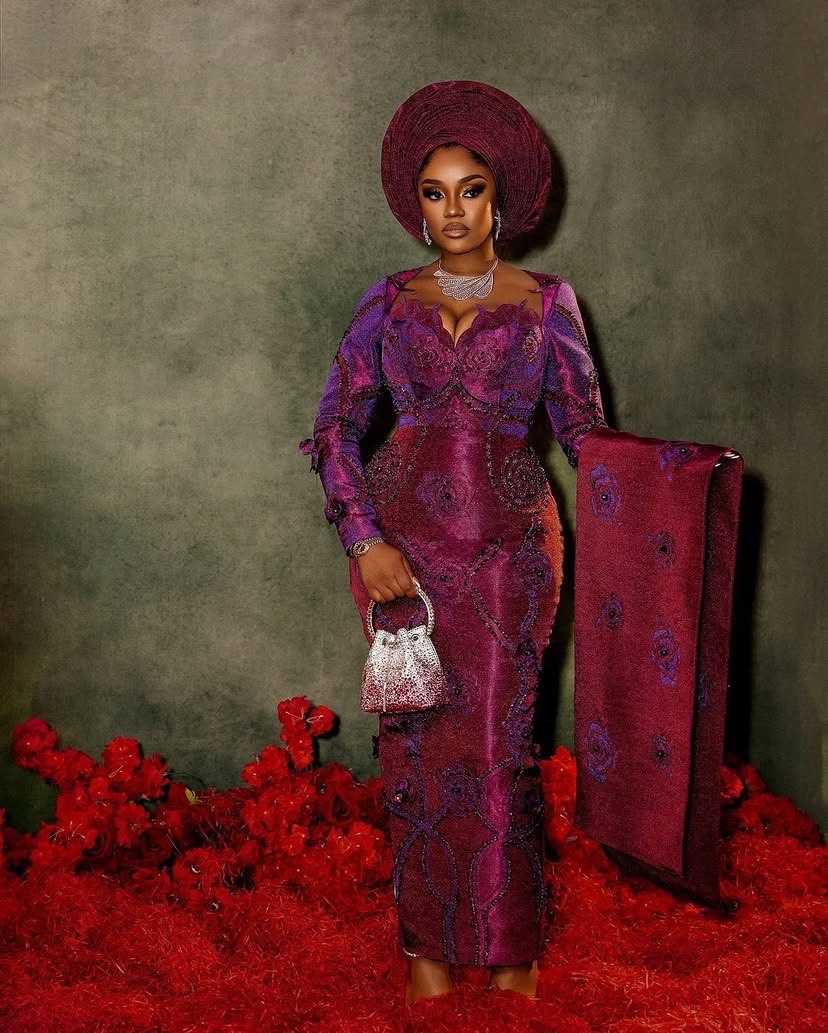
From coral beads to hand-crafted fans, accessories are no longer afterthoughts in Nigerian bridal attire. Today, they extend the gown’s story, completing the look with purpose.
Chioma Adeleke’s CHIVIDO2024 wedding captured this shift. Her attire—custom aso oke by Woven Market Africa and tailored by Couture by Tabik—came in rich tones of wine and purple. The laser-cut floral motifs, the designer explained, symbolized love and joy. Meanwhile, intricate beadwork added both depth and poetry.
Her layered wine gele by Taiwo’s Touch, paired with a matching laser-cut fan and Jimmy Choo heels, tied everything together. The result was a look that merged Nigerian tradition with global luxury.
The Future of Modern Nigerian Bridal Style
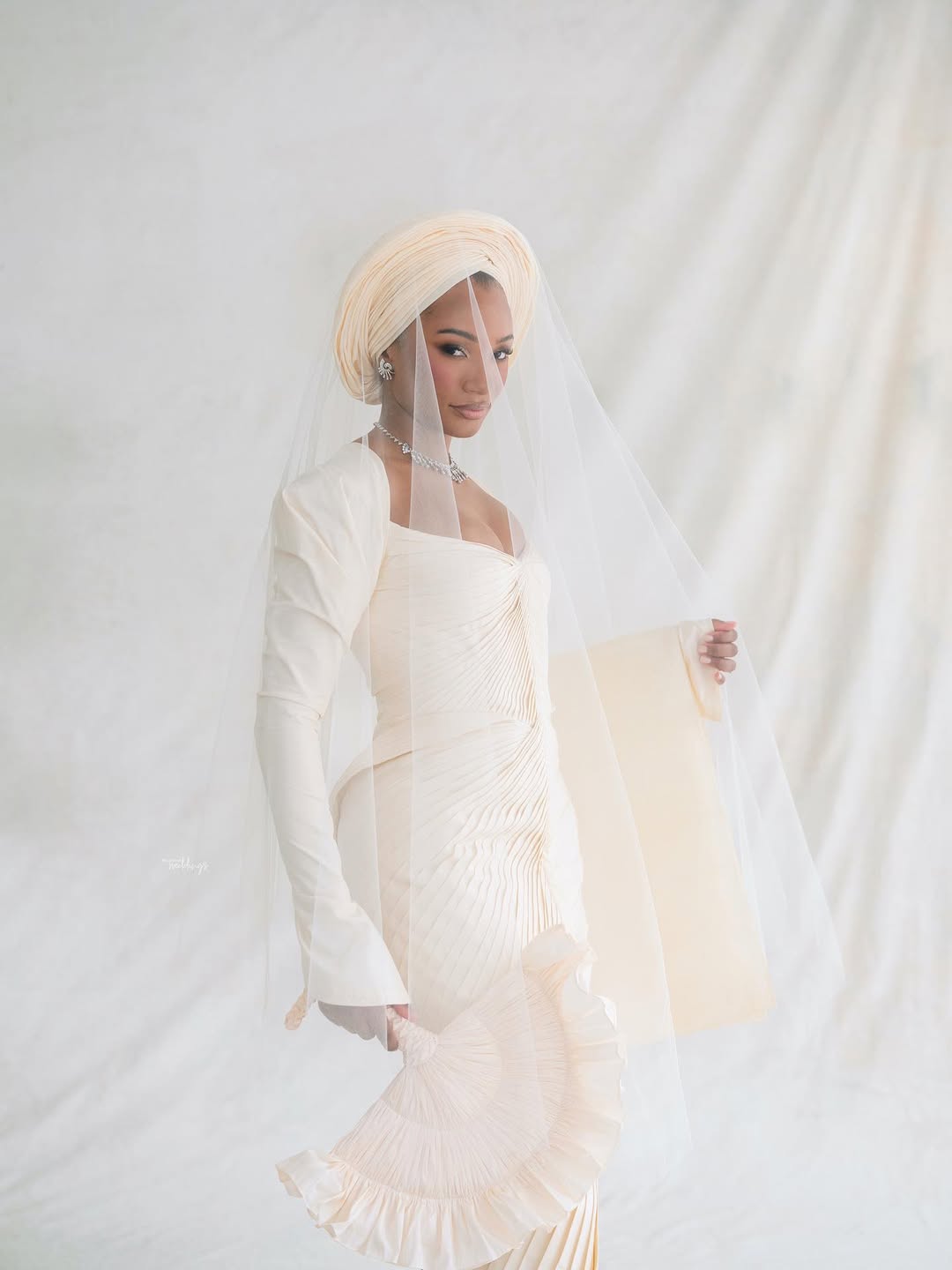
The rise of modern Nigerian bridal attire is more than fashion; it is cultural storytelling amplified by global visibility. Designers are experimenting with textures, inventing fabrics, and shaping silhouettes that capture attention far beyond Nigeria’s borders. Collaborations with international names, such as Temi Otedola’s with Sohee Park, underscore how Nigerian bridal fashion has become a global language that speaks of heritage, love, and innovation.
In 2025, Nigerian brides are not only redefining tradition; they are also setting the global standard for couture. Yet at the heart of this movement lies the steady pulse of tradition. Fabrics like aso oke, Akwaocha, and lace remain the foundation, even as they are reimagined into forms and stories once thought impossible.
For the latest in fashion, lifestyle, and culture, follow us on Instagram @StyleRave_
—Read also
Inside the Elegant Wedding of Temi Otedola and Mr Eazi: A Celebration Across Three Countries
